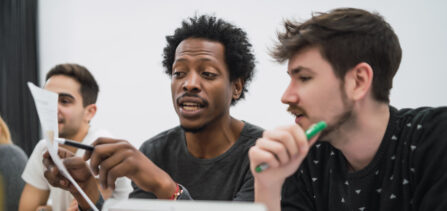
Top Advice on Critical and Creative Thinking
Critical and creative thinking techniques can be learned and nurtured. These problem-solving skills are extremely valuable assets
Critical and creative thinking have become increasingly important in the workplace. They lead to greater innovation and problem-solving and ensure businesses remain agile, move forwards and stay ahead of the competition.
According to the World Economic Forum, three of the top skills needed to succeed today are complex problem-solving, critical thinking, and creativity.
Defining critical and creative thinking is one thing but implementing it in the workplace is far harder. So, what is critical and creative thinking, why is it so important, and what can people and businesses do to help foster critical and creative thinking skills?
Critical and Creative Thinking Podcast
What is Critical Thinking?
There are many definitions of critical and creative thinking. Since the days of Ancient Greece, where philosophers like Plato and Socrates debated the topic, critical thinking in particular has remained of key interest.
Albert Einstein described it as follows:
“To raise new questions, new possibilities, to regard old problems from a new angle, requires creative imagination and marks real advance in science.”
Albert Einstein
Many writers on the subject of critical thinking cite the ability to think clearly and independently, and to connect different ideas together to reach an optimal solution.
Critical and creative thinkers are active learners, rather than passively receiving information. They question current ideas and assumptions and ask new and different questions to see if their existing knowledge represents the whole picture.
People with critical thinking skills tend to:
- Draw connections between questions, problems, and ideas
- Consider all reasonable ideas and possibilities
- Are self-confident and motivated in their ability to reason
- View problems as a challenge rather than a hindrance
- Evaluate and assess a broad range of ideas and viewpoints
- Are open-minded and actively learn without bias
- Gather new information, explanations, and findings
- Take time to come up with solutions
- Network with people who have different ideas and perspectives
- Take risks and understand that there is success in failure
- Communicate effectively with others when finding solutions to complex problems.
Are Only Certain People Creative?
Many people believe critical and creative thinking are innate traits that only certain people have, but this is incorrect. Critical thinking skills can be learned and nurtured, and creativity is inherent to us all.
The human brain is naturally creative but we can become less creative as we grow up if we start to stick to rules and question our assumptions less and less. It has been found that while a quarter to a third of creativity is innate, the remainder can be cultivated and developed over time.
Another mistake is to think that critical and creative thinking are more relevant to some professions than others. Whether you work as an engineer, teacher, lawyer, or in any other profession, critical thinking, creativity, and problem-solving skills are extremely valuable assets.
Why are Critical and Creative Thinking Skills so Important?
The importance of critical and creative thinking cannot be underestimated. In our daily working lives, we all make thousands of decisions every day, some bigger than others.
However, we can be prone to making hasty choices or simply doing things in certain ways through habit or routine, usually relying on tried-and-proven methods because they are easier. In a world where everyone is increasingly busy, we do not take the time or have the foresight to examine whether there are better solutions to the problems we encounter.
Furthermore, critical and creative thinking have become extremely important outside the office as well. For example, critical thinking in particular helps us to identify misinformation that could otherwise cause us to make choices that are not to our advantage.
Speed and Efficiency
Critical and creative thinking is important across all levels and functions of an organisation. Technology and the working world are moving faster than ever, and the level of connections makes it more complex. We have to deal with change quickly and effectively.
Even though the use of AI is becoming increasingly common, it is still largely unable to arrive at the kind of unique critical and creative solutions that humans do. Therefore, there is still a focus on our flexible intellect and creativity when it comes to solving issues.
Planning Strategy
Critical and creative thinking are essential for managers when it comes to planning strategy. This is not only about realising the best solutions but being able to express and communicate them to a wider audience.
By design, creative processes encourage collaboration, teamwork, and more effective communication. Team bonding also helps engagement and employee retention.
Businesses and individuals need to challenge assumptions about what they do and why. Most importantly, they must consider if solutions still work, or if are there better ways to solve business problems.
Businesses that embrace uncertainty, demand innovation and do not fear failure tend to reap the biggest rewards as they often end up leading disruption in their market.
How to Promote Critical Thinking in the Workplace
Many businesses understand the need to be more creative, and encourage employees to ‘think outside the box.’ At the same time, businesses cannot expect their staff to magically offer innovative ideas. A critical and creative thinking environment needs to be carefully nurtured and developed, in addition to being given time to flourish.
Companies need to foster open discussions, encourage open and honest feedback, and embrace the real issues rather than the symptoms. They should not place incentives on goals that undermine critical and creative thinking, such as over-emphasising deadlines and output. It also means taking time to understand the creative needs of team members, including their workstyles and personalities.
Ideas to Improve Critical and Creative Thinking
Understand Innovation Versus Repackaging
Unfortunately, it is all too easy to fall into the trap of repackaging rather than innovating. One of the key differences between these two activities is the level of critical thinking and creativity applied.
If invention is the creation of something entirely new, innovation is taking something that already exists and finding new ways to provide even greater value. That could be adding new features that expand its usefulness, or redesigning it to serve another market or purpose. In contrast, repackaging is simply taking something that already exists and changing it in a largely inconsequential way.
Exercises such as rebranding need to occur from time to time, but never fall into the trap of mistaking repackaging for innovation. Your customer isn’t likely to make the same mistake. They can quickly spot a product or service that serves exactly the same purpose it used to.
Make Sure Everyone Understands How to Innovate
Your team must be capable of having good ideas that guide them towards meaningful innovation. Most notably, this is about using the breadth of valuable techniques that get you thinking outside the box.
If ‘the box’ is the normal way of doing things, then innovating is the application of techniques such as challenging assumptions, looking at concepts from different perspectives, and undertaking blue-sky thinking to break free of creative shackles.
Make Time for Progress
One of the biggest challenges for businesses that are looking to improve their critical and creative thinking is giving employees the time needed to experiment with ideas.
Fifteen percent time was invented by William McKnight of 3M. Employees were encouraged to spend 15 percent of their time daydreaming, doodling, and experimenting to foster innovation. Google employees now dedicate 20 percent of their time to side projects and ideas.
Naturally, this can be easier said than done in a busy team with tight budgets. However, allowing team members some dedicated thinking time about their roles could bring about innovation that increases efficiency and revenue.
Reward Experimentation and Ideas
Nothing dulls creativity and innovation faster than fear of failure, so a certain amount of risk-taking should be promoted.
Businesses should celebrate their employees’ ideas, even if they fail. The concept that ‘no idea is a bad idea’ puts employees at ease and encourages them to share their wilder thoughts. This kind of thinking is often based on entirely new perspectives and, even if impractical, may spark fresh avenues of thought in other people.
Actively ask for suggestions, and encourage people to share their ideas. Leaders also need to be ready and willing to bring fresh ideas to the table.
Build Diverse Teams
Always populate your teams with different skill sets, backgrounds and strengths as this encourages healthy debate and different points of view.
A room full of similar people will have a similar approach that greatly narrows the perspective of your critical and creative thinking. In contrast, the Medici Effect argues that a more diverse team has a better chance of generating disruptive ideas. Allow everyone equal input, and watch your brainstorming and idea sessions thrive.
Optimise Your Workspace
Does your physical environment lend itself to creativity? A Cornell University study found that the physical environment has a huge impact on the level of productivity and creativity in a workplace.
Create clear and clutter-free spaces with plenty of natural light and good airflow to encourage creative and critical thinking abilities. Increasing the number of collaborative working spaces also helps to promote creativity, as does reducing the tendency toward siloing employees with walls and dividers.
Critical and Creative Thinking
Impact Factory runs
Open Strategic Thinking Courses
Tailored Strategic Thinking Training
Five-Day Intensive Communicate With Impact Workshops
and personalised
One-to-One Critical Creative Thinking Training
for anyone who is interested in Strategic Thinking Issues




